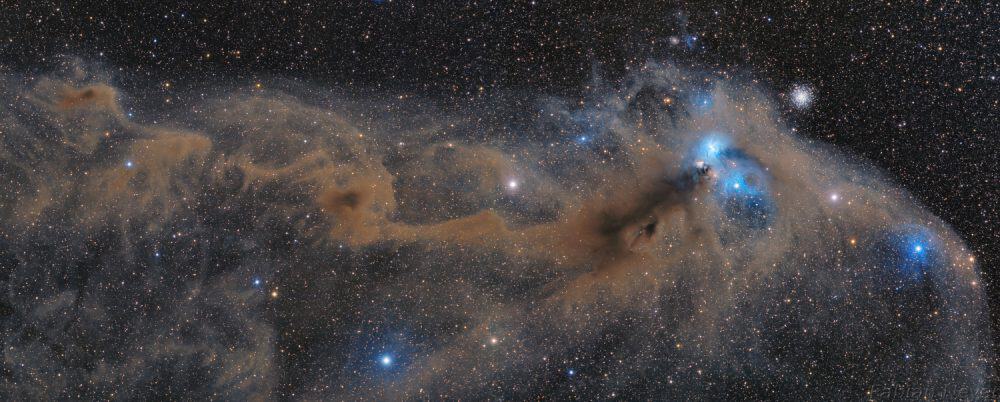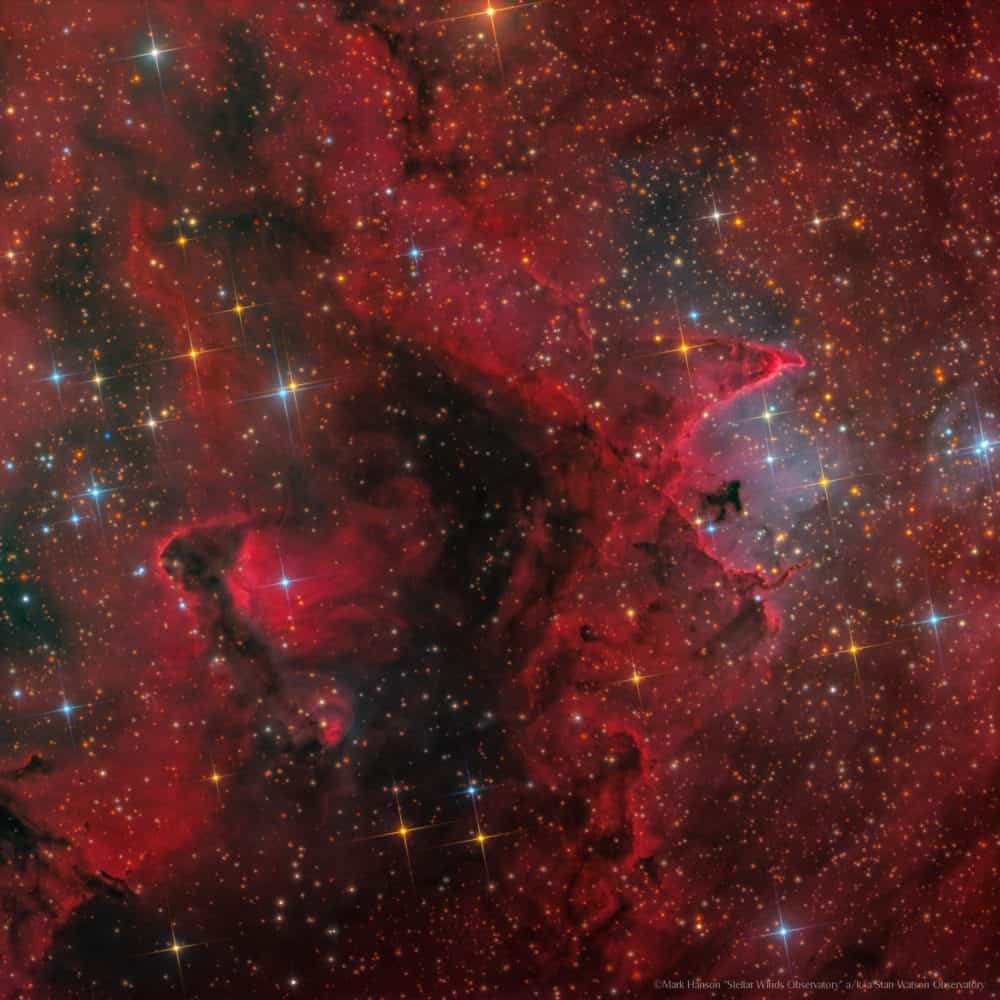Blog
Rhythm Roots Workshop solo performance
PRI Minneapolis 11-30-18 noon-2pm
This is the conclusion of a Art Access Residency
more...NGC 7552 (also known as IC 5294) is a barred spiral galaxy in constellation Grus. It is at a distance of circa 60 million light years from Earth, which, given its apparent dimensions, means that NGC 7552 is about 75,000 light years across. It forms with three other spiral galaxies the Grus Quartet.
NGC 7552 was originally discovered and reported in 1826 by James Dunlop and John Herschel added it in the General Catalogue of Nebulae and Clusters as number 3977. However, Lewis Swift reported the galaxy independently in on October 22, 1897, at right ascention 9 arcseconds off the location of the galaxy and was included in Index Catalogue as IC 5294
more...Jack Sheldon (born November 30, 1931) is an American bebop and West Coast jazz trumpeter, singer, and actor. He is a trumpet player and was the music director on The Merv Griffin Show, as well as the voice heard on several episodes of the educational music television series Schoolhouse Rock!
Sheldon was born in Jacksonville, Florida. He originally became known through his participation in the West Coast jazz movement of the 1950s, performing and recording with such figures as Art Pepper, Gerry Mulligan, and Curtis Counce. Sheldon played the trumpet, sang, and performed on The Merv Griffin Show. He was Griffin’s sidekick for many years.
https://www.youtube.com/watch?v=gmVNhgrKnxY
more...Walter Brown “Brownie” McGhee (November 30, 1915 – February 16, 1996) was an African-American folk music and Piedmont blues singer and guitarist, best known for his collaboration with the harmonica player Sonny Terry.
McGhee was born in Knoxville, Tennessee, and grew up in Kingsport, Tennessee. At about the age of four he contracted polio, which incapacitated his right leg. His brother Granville “Sticks”(or “Stick”) McGhee, who also later became a musician and composed the famous song “Drinkin’ Wine Spo-Dee-o-Dee,” was nicknamed for pushing young Brownie around in a cart. Their father, George McGhee, was a factory worker, known around University Avenue for playing guitar and singing. Brownie’s uncle made him a guitar from a tin marshmallow box and a piece of board.
McGhee spent much of his youth immersed in music, singing with a local harmony group, the Golden Voices Gospel Quartet, and teaching himself to play guitar. He also played the five-string banjo and ukulele and studied piano. Surgery funded by the March of Dimes enabled McGhee to walk.
more...Robert Lee McCollum (November 30, 1909 – November 5, 1967) was an American blues musician who played and recorded under the pseudonyms Robert Lee McCoy and Robert Nighthawk. He was the father of the blues musician Sam Carr.
McCollum was born in Helena, Arkansas. He left home at an early age and became a busking musician. After a period traveling through southern Mississippi, he settled for a time in Memphis, Tennessee, where he played with local orchestras and musicians, such as the Memphis Jug Band. A particular influence during this period was Houston Stackhouse, from whom he learned to play slide guitar and with whom he performed on the radio in Jackson, Mississippi.
more...World Music on Flamenco Fridays with Paco de Lucia
more...Cosmic dust clouds are draped across a rich field of stars in this broad telescopic panorama near the northern boundary of Corona Australis, the Southern Crown. Less than 500 light-years away the denser clouds effectively block light from more distant background stars in the Milky Way. The entire vista spans about 5 degrees or nearly 45 light-years at the clouds’ estimated distance. Toward the right lies a group of bluish reflection nebulae cataloged as NGC 6726, 6727, 6729 and IC 4812. The characteristic blue color is produced as light from hot stars is reflected by the cosmic dust. The dust also obscures from view stars in the region still in the process of formation. Smaller yellowish nebula NGC 6729 surrounds young variable star R Coronae Australis. Below it are arcs and loops identified as Herbig Haro (HH) objects associated with energetic newborn stars. Magnificent globular star cluster NGC 6723 is above and right of the nebulae. Though NGC 6723 appears to be part of the group, its ancient stars actually lie nearly 30,000 light-years away, far beyond the young stars of the Corona Australis dust clouds.
more...Billy Hart (born November 29, 1940) is an American jazz drummer and educator.
Hart was born in Washington, D.C., where early on in his career he performed with soul artists such as Otis Redding and Sam and Dave, and then later with Buck Hill and Shirley Horn, and was a sideman with the Montgomery Brothers (1961), Jimmy Smith (1964–1966), and Wes Montgomery(1966–68). Following Montgomery’s death in 1968, Hart moved to New York, where he recorded with McCoy Tyner, Wayne Shorter, and Joe Zawinul, and played with Eddie Harris, Pharoah Sanders, and Marian McPartland.
Hart was a member of Herbie Hancock‘s sextet (1969–73), and played with McCoy Tyner (1973–74), Stan Getz (1974–77), and Quest (1980s), in addition to extensive freelance playing (including recording with Miles Davis on 1972’s On the Corner).
Since the early 1990s, Hart has been associated with Oberlin Conservatory of Music, and is also adjunct faculty at the New England Conservatory of Music and Western Michigan University. He also conducts private lessons through the New School and New York University. The drummer often contributes to the Stokes Forest Music Camp and the Dworp Summer Jazz Clinic in Belgium.
He has led a group with Mark Turner, Ethan Iverson, and Ben Street, is featured in a trio led by pianist Jean-Michel Pilc, another led by guitarist Assaf Kehati, and has performed in a band known as the Cookers, with Eddie Henderson, David Weiss, Craig Handy, George Cables and Cecil McBee, all who have toured extensively and recorded two CD.
more...John Mayall, OBE (born 29 November 1933) is an English blues singer, guitarist, organist and songwriter, whose musical career spans over sixty years. In the 1960s, he was the founder of John Mayall & the Bluesbreakers, a band which has counted among its members some of the most famous blues and blues rock musicians. They include Eric Clapton, Peter Green, Jack Bruce, John McVie, Mick Fleetwood, Mick Taylor, Don “Sugarcane” Harris, Harvey Mandel, Larry Taylor, Aynsley Dunbar, Hughie Flint, Jon Hiseman, Dick Heckstall-Smith, Andy Fraser, Johnny Almond, Walter Trout, Coco Montoya, Kal David, and Buddy Whittington.
more...William Thomas “Billy” Strayhorn (November 29, 1915 – May 31, 1967) was an American jazz composer, pianist, lyricist, and arranger, best remembered for his long-time collaboration with bandleader and composer Duke Ellington that lasted nearly three decades. His compositions include “Take the ‘A’ Train“, “Chelsea Bridge“, “A Flower Is a Lovesome Thing“, and “Lush Life“.
Strayhorn was born in Dayton, Ohio.
more...Brigada Victor Jara was formed in Coimbra, Portugal in 1974, following the April 25 revolution, in which traditional music had played an inspiring part. The band took its name from the Chilean folk singer murdered by the military after the Pinochet coup of 1973.
more...https://www.youtube.com/watch?v=Ml13OAEtNQw
more...This cosmic close-up looks deep inside the Soul Nebula. The dark and brooding dust clouds on the left, outlined by bright ridges of glowing gas, are cataloged as IC 1871. About 25 light-years across, the telescopic field of view spans only a small part of the much larger Heart and Soul nebulae. At an estimated distance of 6,500 light-years the star-forming complex lies within the Perseus spiral arm of our Milky Way Galaxy, seen in planet Earth’s skies toward the constellation Cassiopeia. An example of triggered star formation, the dense star-forming clouds of IC 1871 are themselves sculpted by the intense winds and radiation of the region’s massive young stars. The featured image appears mostly red due to the emission of a specific color of light emitted by excited hydrogen gas.
more...Randall Stuart Newman (born November 28, 1943 LA,CA) is an American singer-songwriter, arranger, composer, and pianist who is known for his distinctive voice, mordant (and often satirical) pop songs, and for film scores.
Since the 1980s, Newman has worked mostly as a film composer. His film scores include Ragtime, Awakenings, The Natural, Leatherheads, Cats Don’t Dance, Meet the Parents, Cold Turkey, and Seabiscuit. He has scored eight Disney–Pixar animated films: Toy Story, A Bug’s Life, Toy Story 2, Monsters, Inc., Cars, Toy Story 3, Monsters University, and Cars 3, as well as Disney’s The Princess and the Frog and James and the Giant Peach.
Newman has received twenty Academy Award nominations in the Best Original Score and Best Original Song categories and has won twice in the latter category. He has also won three Emmys, seven Grammy Awards, and the Governor’s Award from the Recording Academy.
Newman was inducted into the Songwriters Hall of Fame in 2002 for classics such as “Short People“, and as a Disney Legend in 2007. Newman was inducted to the Rock and Roll Hall of Fame in April 2013.
more...Leandro “Gato” Barbieri (28 November 1932 – 2 April 2016) was an Argentine jazz tenor saxophonist who rose to fame during the free jazz movement in the 1960s and is known for his Latin jazz recordings of the 1970s. His nickname, Gato, is Spanish for “cat”.
Born to a family of musicians, Barbieri began playing music after hearing Charlie Parker‘s “Now’s the Time”. He played the clarinet and later the alto saxophone while performing with the Argentinean pianist Lalo Schifrin in the late 1950s. By the early 1960s, while playing in Rome, he also worked with the trumpeter Don Cherry. By now influenced by John Coltrane‘s late recordings, as well as those from other free jazz saxophonists such as Albert Ayler and Pharoah Sanders, he began to develop the warm and gritty tone with which he is associated. In the late 1960s, he was fusing music from South America into his playing and contributed to multi-artist projects like Charlie Haden‘s Liberation Music Orchestra and Carla Bley‘s Escalator Over The Hill. His score for Bernardo Bertolucci‘s 1972 film Last Tango in Paris earned him a Grammy Award and led to a record deal with Impulse! Records
more...Roy McCurdy (born November 28, 1936) is a jazz drummer.
Before joining Cannonball Adderley‘s Quintet in 1965 and staying with the band until Adderley’s death in 1975, he had played with Chuck and Gap Mangione in the Jazz Brothers (1960–1961), as well as with Bobby Timmons, Betty Carter and Sonny Rollins (1963–1964), appearing on the classic 1963 album Sonny Meets Hawk!
He attended the Eastman School of Music from sixteen to eighteen, during which time he also played professionally with Roy Eldridge and with Eddie Vinson at seventeen. In 1960 he joined the Art Farmer – Benny Golson Jazztet and remained for two years.
Among the influences he cites Louie Bellson, Shelly Manne, Sam Woodyard, Buddy Rich, Papa Jo Jones, Philly Joe Jones and the bands of Duke Ellington, Jimmie Lunceford and Lionel Hampton.
He has also played and/or recorded with Count Basie, Wes Montgomery, Ella Fitzgerald, Sarah Vaughan, Carmen McRae, Joe Williams, Herbie Hancock, Oscar Peterson, Bud Powell, Art Pepper, and the jazz rock group Blood, Sweat and Tears, etc.
more...Gigi Gryce (born George General Grice Jr.; November 28, 1925 – March 14, 1983) was an American jazz saxophonist, flautist, clarinetist, composer, arranger, and educator.
While his performing career was relatively short, much of his work as a player, composer, and arranger was quite influential and well-recognized during his time. However, Gryce abruptly ended his jazz career in the 1960s. This, in addition to his nature as a very private person, has resulted in very little knowledge of Gryce today. Several of his compositions have been covered extensively (“Minority“, “Social Call”, “Nica’s Tempo”) and have become minor jazz standards. Gryce’s compositional bent includes harmonic choices similar to those of contemporaries Benny Golson, Tadd Dameron and Horace Silver. Gryce’s playing, arranging, and composing are most associated with the classic hard bop era (roughly 1953–1965). He was a well-educated composer and musician, and wrote some classical works as a student at the Boston Conservatory. As a jazz musician and composer he was very much influenced by the work of Charlie Parker and Thelonious Monk.
George General Grice Jr. was born in Pensacola, Florida on November 28, 1925
more...Portugal
more...More Posts
- James Jamerson
- Ed Shaughnessy
- World Music with Yuval Ron
- Daily Roots with Peter Broggs
- Rocky Horror Picture Show 2022
- Cosmos IC 1871/SFO 12
- King Tubby
- John Williams
- Ronnie Scott
- Flamenco Fridays with José del Tomate
- Daily Roots with Johnny Osbourne
- Cosmos NGC 1999
- Bobby Hutcherson
- Bobby Blue Bland
- Elmore James
- Hot Lips Page
- Wolfgang Amadeus Mozart
- Daily Roots with Junior Byles
- Cosmos UGC 11537
- Huey Piano Smith



